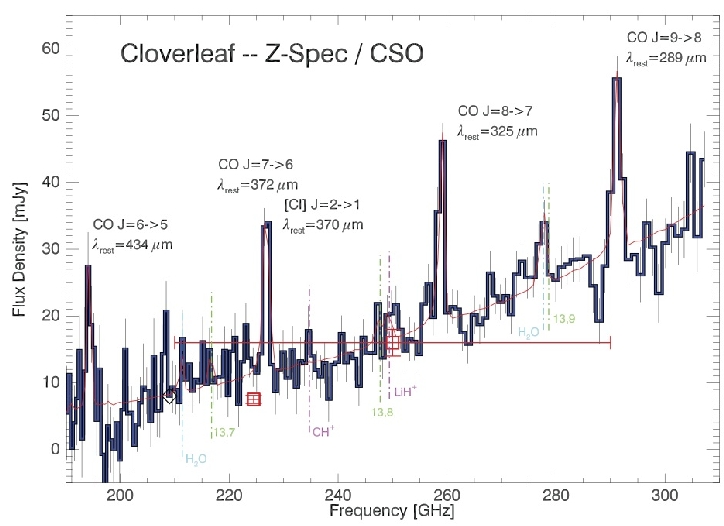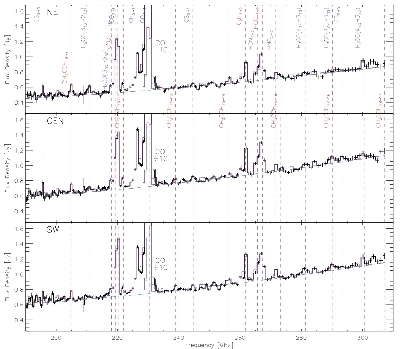
 Measuring
redshifts of distant star-forming galaxies using Z-Spec at the CSO
Measuring
redshifts of distant star-forming galaxies using Z-Spec at the CSO 
A major thrust of research
in modern astrophysics is to build an understanding of galaxy
formation, particularly early in the Universe, within several billion
years of the Big Bang.
The earliest stages of galaxy formation can be difficult to observe at
optical and ultraviolet
wavelengths because light emitted by young stars is absorbed by
dust. However, galaxies
with embedded star formation are bright at infrared and submillimeter
wavelengths, and the
molecular gas from which stars form emits line radiation at
submillimeter and millimeter
wavelengths. Astronomers can use molecular line emissions to
measure the distances
(redshifts) to galaxies and to characterize the physical conditions of
interstellar gas, such as
temperature and density. Earth's atmosphere is opaque at some
submillimeter and millimeter
wavelengths, although there are spectral windows with good
transmission. The 1.0 - 1.5 mm
window has very good atmospheric transmission and a new instrument
called Z-Spec has
been designed to observe in this band from the CSO to measure redshifts
of distant, star-
forming galaxies, and to characterize the interstellar medium of nearby
galaxies. Z-Spec
gets its name from "Z", the letter conventionally used for redshift in
astronomy, and "Spec"
for spectrometer.
Z-Spec began in the late 1990s at Caltech and NASA JPL, and were
soon joined by the
University of Colorado, Boulder, and JAXA in Japan. The
University of Pennsylvania
is now a key collaborator also. Z-Spec is a direct-detection
spectrometer, which uses a
waveguide-coupled diffraction grating to disperse (and focus)
millimeter-wavelength light
onto an array of 160 silicon nitride micromesh bolometers. When
photons are absorbed
by bolometers, their temperatures increase a very small amount, which
causes a measurable
change in their electrical resistance. The detectors must be kept
extremely cold in order to
be able to detect faint signals from distant galaxies: an
adiabatic demagnetization refrigerator
and closed-cycle helium refrigerator maintain the detectors 0.06
degrees Celsius above the
absolute zero of temperature. The development of Z-Spec led to
two PhD theses for Naylor
(2008) and Earle (2008).
Z-Spec was commissioned at the CSO in 2005, with the spectrum of NGC
6240, a starburst
galaxy with a double nucleus (implying it is the product of two
galaxies that merged),
presented as its first-light observation. Since then,
observations with Z-Spec have led to many
new scientific results. The first major Z-Spec publication,
Bradford et al. (ApJ, 705, 112, 2009),
modeled the physical conditions of the molecular gas in the
high-redshift (z = 2.56) quasar known
as the Cloverleaf (because it is gravitationally lensed and there are
four images) using emission
lines of carbon monoxide. Shortly thereafter, a multi-molecule
study of the nearby starburst
galaxy M82 was published, which presented a new line survey of this
nearby starburst galaxy
obtained with Z-Spec (Naylor, ApJ, in press). In 2010,
redshifts of several galaxies discovered
by the Herschel Space Observatory were measured with Z-Spec (Negrello
et al., in press; Lupu
et al., submitted). These are the first redshifts of
submillimeter galaxies measured in this way.
Most recently, a Z-Spec line survey with of the Seyfert galaxy NGC 1068
has shown that the
disk surrounding the galaxy's supermassive-black-hole-harboring nucleus
contains warm molecular
gas and is likely excited by X-ray emission from the nucleus.

Figure 1: University of Colorado, Boulder, physics Ph.D. student Lieko
Earle working to align Z-Spec's optics at the CSO. At the bottom
of the picture, in the hole in the telescope's primary mirror, are
Jason Glenn, an astrophysics professor at Colorado, and Jamie Bock of
NASA JPL. Photo courtesy Hien Nguyen of NASA JPL.

Figure 2: Z-Spec spectrum of the Cloverleaf Quasar, showing bright
continuum emission from interstellar dust and prominent carbon monoxide
emission lines.

Figure 3: Z-Spec spectrum of the starburst galaxy M82, displaying a
plethora of molecular emission lines.
Go back to A Digest
of Recent News and
Scientific Results at the Caltech Submillimeter Observatory

 Measuring
redshifts of distant star-forming galaxies using Z-Spec at the CSO
Measuring
redshifts of distant star-forming galaxies using Z-Spec at the CSO 

 Measuring
redshifts of distant star-forming galaxies using Z-Spec at the CSO
Measuring
redshifts of distant star-forming galaxies using Z-Spec at the CSO 


